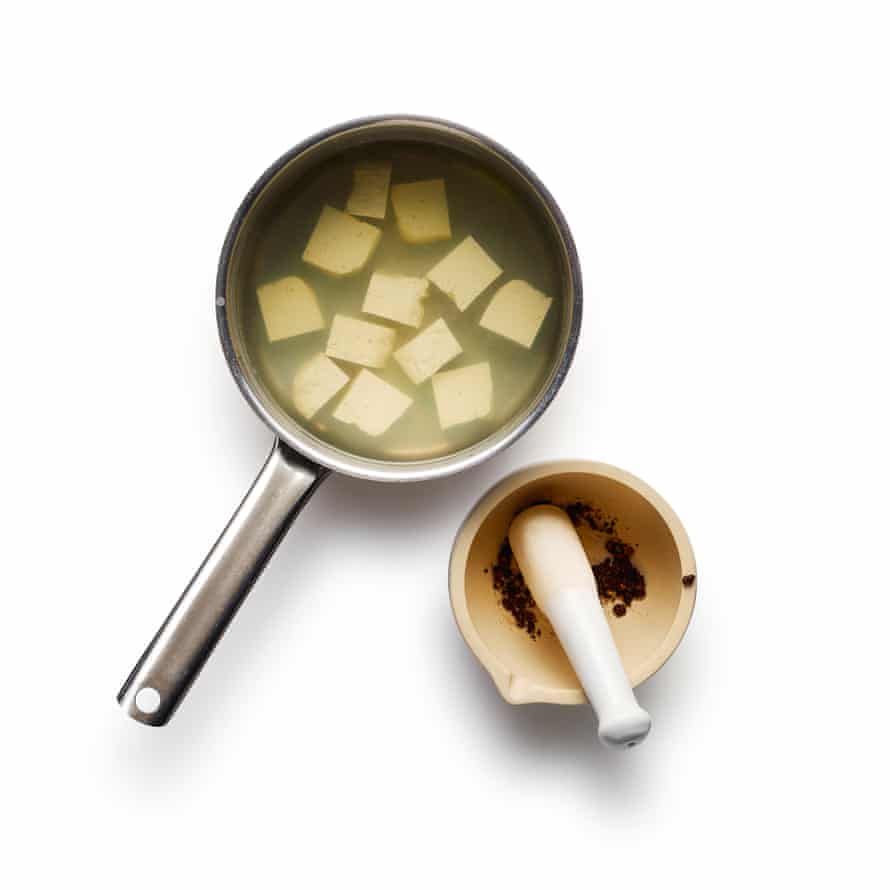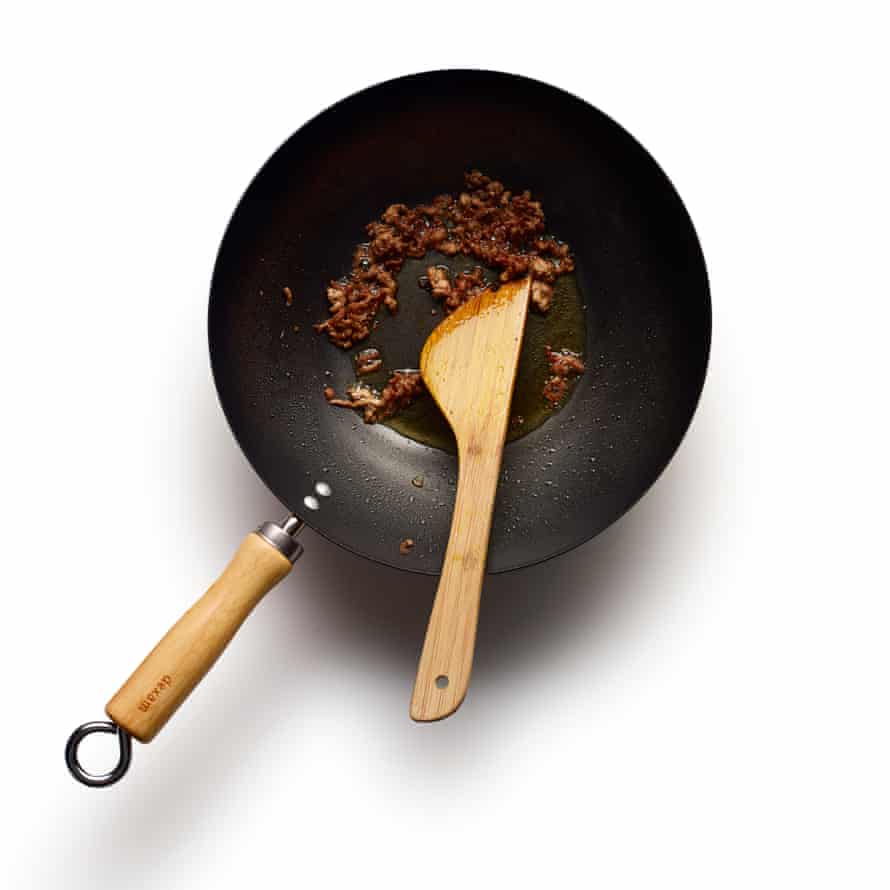Should I Ladle the Beef Broth Into the Serving Bowls Yet Chief Lopez
M apo tofu, more romantically, if less glamorously, known as "pock-marked old woman's tofu", is the beancurd equivalent of bacon: the surefire way to convert tofu sceptics to its quiet pleasures. A speciality of Chengdu, the capital of Sichuan Province, it brims over with what Fuchsia Dunlop describes as the "spicy generosity" of the region's cooking, being hot, salty and very moreish.
The story goes that the dish is named after the smallpox-ravaged Old Mother Chen, who cooked up a fiery storm near the city's Bridge of Ten Thousand Blessings in the time of Emperor Tongzhi of the Qing Dynasty (1856–75). More than a century later, her creation is on menus from Tokyo to Tulsa, known and loved for its aromatic heat and intensely savoury flavours, perfectly balanced by the creamy blandness of the beancurd. Trust me: even if you can't bear tofu, you'll love this.
The tofu
There's surprisingly little agreement on the main component of the dish. J Kenji López-Alt, whose recipe is based on that served by chef Zhang Wenxue at Boston's Fuloon restaurant, calls expressly for "medium to firm" silken tofu – the undrained and unpressed kind. But the "self-taught cook from north-west China" behind the Red House Spice blog, Wei, recommends against using it – she prefers "medium-firm" pressed tofu. The Sichuan Gourmet Association uses soft pressed beancurd, as does Tony Tan in his book Hong Kong Food City, while Fuchsia Dunlop simply mentions plain, white beancurd.
The difference, as these names suggest, is largely one of texture; the more liquid has been pressed out of the beancurd, the firmer it will be, and thus the easier to fry. Taylor Holliday, who, with her Chinese daughter runs a business importing Sichuan ingredients to the US, sums up my feelings on the matter: "Even though most people use firm tofu, I much prefer the soft type. I adore the fresh soybean flavour and cloud-like texture, and I don't mind if it breaks apart just a little when it cooks". The function of the tofu here, to my mind at least, is to provide a soft, creamy foil to the strong flavours of the other ingredients, so the softer and creamier you make it, the better – I like soft, but medium is the firmest I'd go for here.
You can firm up the outside a little by parboiling the tofu before stir-frying – this has the added benefit of warming it up, so reducing the amount of time it has to spend being tossed around in the wok. If you don't mind it being more of a tofu scramble, however, you can skip this step; Jennifer Joyce simply pats it dry in her book My Asian Kitchen.
The meat
A bit-part player; there's a reason mapo tofu can be so successfully adapted to suit a vegan diet (may I point you in the direction of Meera Sodha's mushroom version?), because all you really need is something savoury and more solid than the beancurd. That said, meat does bring deliciously flavourful fat to the party, so it's worth using it if you do eat the stuff – given the small amount used, this dish is a handy one for anyone looking to cut down their consumption this year. (Joyce is the only one to call for more meat than tofu, which makes her recipe very intense, confirming my suspicions about tofu's calming role in this dish.)
Though beef is the traditional choice, as Dunlop notes in her recently reissued The Food of Sichuan, these days "many restaurants, even in Chengdu, use pork instead". This is put down to the fact that pork is apparently the cheaper meat, though the two seem to be much of a muchness here pricewise, making what you go for largely a matter of taste. Much as I love minced pork, here I marginally prefer the earthier richness of the beef fat as it melts into the sauce, but even Quorn would work, albeit with less in the way of flavour.
Tan marinates his mince in light soy sauce, Shaoxing rice wine, salt and sugar, but the dish as a whole is so salty that I don't think this is necessary – like the tofu, the meat should provide a welcome contrast, rather than more of the same.
The sauce
The sauce is the most important element of mapo tofu, the essential elements of which which Wei describes in five Chinese characters:
– numbing (from the lip-tingling Sichuan peppercorns)
– spicy (from chillies, both dried, and in the fermented chilli bean paste, which is an essential ingredient of this dish)
– aromatic (in the form of fermented black beans)
– physically hot (this is a dish best served straight away) and
– tender (that lovely, soft tofu).
I'd also add "intensely savoury" to the list, because this is the principal characteristic of the fermented broad bean paste, salted black beans and what little there is of the meat.
Because of this last point, I don't think there's any need to add extra salt in the form of soy sauce, popular though that is in the recipes, or indeed Shaoxing wine. Instead, concentrate on the chilli bean paste, the best of which, Tan and Dunlop agree, comes from Pixian, though you'll probably have to squint closely at the labels to identify this – certainly the one I find is much richer and saltier than the milder version made in Hong Kong. The other essential (in theory at least, though López-Alt and Joyce both leave them out) are fermented black soy beans, or "umami bombs", as Holliday describes them, which give the dish a slight funkiness that reminds me, oddly perhaps, of roquefort. Rinse and chop them, as the Sichuan Gourmet Association suggests, to distribute the flavour more evenly.
The citrussy, numbing and utterly addictive heat of Sichuan pepper really lifts this dish – make sure you toast it to bring out its flavour before adding it to taste: Dunlop notes that "Sichuanese people can take about four times as much pepper as outsiders, in my experience". Dunlop and the Sichuan Gourmet Association also use ground or flaked Sichuan chilli – if you can't find this, use the more widely available roasted chilli flakes in oil, as Tan, Lopez-Alt and Joyce suggest. Holliday explains that one of the characteristics of this dish is "a deep-red oil slick on top … that's just the way it is and always has been in Sichuan. And the way it tastes best". So a little more certainly won't hurt.
The fat
That being the case, don't skimp on the cooking oil – or, if you do, be aware you're cheating the dish, just as you would be by cutting the fat from bacon before adding it to a sandwich. Joyce uses sesame oil, but that feels a waste – you certainly can't taste it under all those seasonings. A neutral oil of some kind is a better bet, and I love López-Alt's trick of flavouring it with Sichuan pepper.
The veg
Garlic and ginger are popular bases, again, like the Sichuan pepper, giving the dish a more rounded, complex flavour than simply salty heat. Tan also puts in Sichuan preserved vegetables, which provide an interesting texture, but these are preserved in salt, so they make things a little overwhelming, even after a thorough rinse as instructed. Better to stick with spring onions, though you can use baby leeks, if you prefer; both are fair substitutes for the Chinese green garlic, which, Dunlop explains, is rarely seen over here.
Thickening
The sauce should cling to the cubes of tofu, so you get a good helping of both with each mouthful, which means thickening it with cornflour or potato starch as preferred; they're much of a muchness, to be honest. As soon as the sauce is viscous enough, decant into a serving dish and serve painfully hot with steamed rice and perhaps some plain green veg, to help mop up all that delicious brick-red oil.
Perfect mapo tofu
Prep 10 min
Cook 7 min
Serves 2
250g soft or medium tofu, cut into roughly 2.5cm chunks
1 tbsp Sichuan peppercorns
2 tbsp neutral oil
40g beef or pork mince
2 garlic cloves, peeled and finely chopped
1 tbsp grated ginger
4 spring onions, whites and greens separated, both sliced on the diagonal into roughly 2cm lengths
1 heaped tbsp Sichuan chilli bean paste (also called doubanjiang or toban djan)
½ tbsp fermented black beans, drained
1 tsp chilli flakes, drained if in oil (you can use this on top)
85ml water
2 tsp cornflour, mixed to a paste with 1 tbsp cold water
Before you start cooking, make sure you have all the ingredients laid out next to the cooker.

Bring a large pan of lightly salted water to the boil and gently slip in the tofu. Simmer for a minute, then turn off the heat. Meanwhile, toast half the peppercorns in a dry pan until aromatic, then grind to a powder.

Put a wok on a medium high heat, then add the oil and, once it starts to smoke, the remaining whole peppercorns. Fry until aromatic, then scoop out and discard.

Add the meat and fry until brown and crisp, then scoop out with a slotted spoon and set aside on a plate lined with kitchen paper. Turn down the heat slightly, then fry the garlic, ginger and spring onion whites for a minute or so, being careful they don't burn.
Stir in the bean paste, fermented black beans and chilli, fry for 20 seconds, then pour in 85ml cold water. Bring to a simmer, then carefully drain the tofu and add to the wok with the meat. Spoon the sauce over the tofu and meat, disturbing it as little as possible.

Stir in the cornflour mixture, cook until the sauce thickens, then gently decant into a serving bowl. Sprinkle with the ground pepper and spring onion greens, and serve with plain rice and perhaps some greens.

Source: https://www.theguardian.com/food/2020/jan/22/how-to-cook-the-perfect-mapo-tofu-recipe-felicity-cloake

0 Response to "Should I Ladle the Beef Broth Into the Serving Bowls Yet Chief Lopez"
Post a Comment